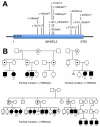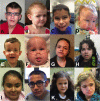The phenotypic spectrum of Schaaf-Yang syndrome: 18 new affected individuals from 14 families
- PMID: 27195816
- PMCID: PMC5116288
- DOI: 10.1038/gim.2016.53
The phenotypic spectrum of Schaaf-Yang syndrome: 18 new affected individuals from 14 families
Erratum in
-
CORRIGENDUM: The phenotypic spectrum of Schaaf-Yang syndrome: 18 new affected individuals from 14 families.Genet Med. 2016 Oct;18(10):1066. doi: 10.1038/gim.2016.114. Genet Med. 2016. PMID: 27684311 No abstract available.
Abstract
Purpose: Truncating mutations in the maternally imprinted, paternally expressed gene MAGEL2, which is located in the Prader-Willi critical region 15q11-13, have recently been reported to cause Schaaf-Yang syndrome, a Prader-Willi-like disease that manifests as developmental delay/intellectual disability, hypotonia, feeding difficulties, and autism spectrum disorder. The causality of the reported variants in the context of the patients' phenotypes was questioned, as MAGEL2 whole-gene deletions seem to cause little or no clinical phenotype.
Methods: Here we report a total of 18 newly identified individuals with Schaaf-Yang syndrome from 14 families, including 1 family with 3 individuals found to be affected with a truncating variant of MAGEL2, 11 individuals who are clinically affected but were not tested molecularly, and a presymptomatic fetal sibling carrying the pathogenic MAGEL2 variant.
Results: All cases harbor truncating mutations of MAGEL2, and nucleotides c.1990-1996 arise as a mutational hotspot, with 10 individuals and 1 fetus harboring a c.1996dupC (p.Q666fs) mutation and 2 fetuses harboring a c.1996delC (p.Q666fs) mutation. The phenotypic spectrum of Schaaf-Yang syndrome ranges from fetal akinesia to neurobehavioral disease and contractures of the small finger joints.
Conclusion: This study provides strong evidence for the pathogenicity of truncating mutations of the paternal allele of MAGEL2, refines the associated clinical phenotypes, and highlights implications for genetic counseling for affected families.Genet Med 19 1, 45-52.
Figures



References
Publication types
MeSH terms
Substances
Grants and funding
LinkOut - more resources
Full Text Sources
Other Literature Sources
Medical

